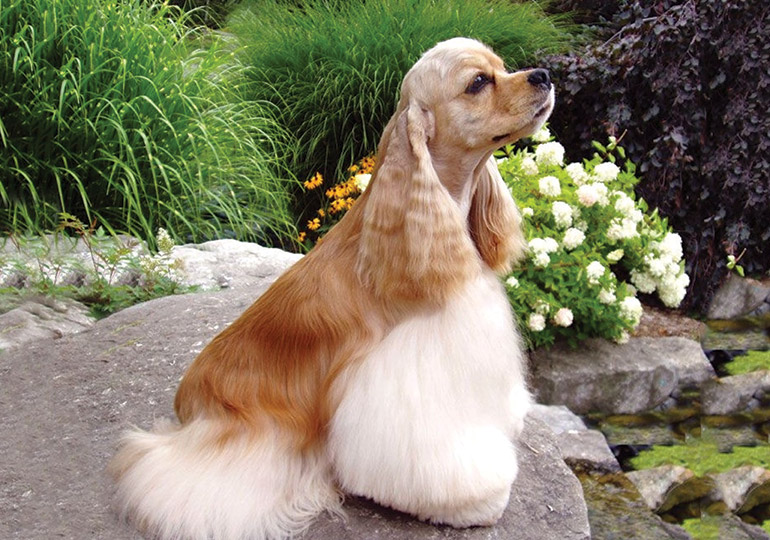
GROUP 3 - GUNDOGS
The Cocker Spaniel (American) is the smallest member of the Gundog Group, and is ideally suited as a family pet.
The first spaniel in America came across with the Mayflower in 1620, but it was not until 1878 that the first American Cocker Spaniel was registered with the American Kennel Club.
In 1946 the AKC recognised the English and American types as separate breeds. It was not until 1970 that The Kennel Club in the UK recognised the American Cocker Spaniel as being separate from the English type.
The first American Cocker Spaniels arrived in Australia in the 1960s.
They were originally bred and used as successful gun dogs and hunting dogs to flush ground dwelling game, but are now a very strong competitor in dog shows, as well as obedience and agility trials.
A small to medium dog of compact build.
Height: Bitch - 35.6 cm (14 ins). Dog - 38.1 cm (15 ins)
Colours: Solid - Black, Brown, Buff - with or without Tan markings.
Parti-colour – white, with any of the coloured patches above, and includes Roans The coat can be silky, wavy or flat. The eyes are round and dark, and the ears are low-set and feathered.
The average weight ranges between 8 and 12 kilograms.
The American Cocker Spaniel is intelligent, gentle, playful, devoted, dependable and can be amusing.
They have a strong desire to hunt and retrieve, and are happy to work. American Cocker Spaniels are generally easy to train, and have excelled in Obedience, Agility, and Field work in Australia.
They can also be shy, so thorough socialisation is required. They are good with other pets and children, but supervision is always advised.
An American Cocker Spaniel Pup should always be chosen from healthy stock. This Breed can be prone to some inherited eye diseases. However, the majority of breeders in Australia test their breeding dogs annually, so these problems have greatly reduced. Purchasers should insist on seeing a current eye certificate for both parents. Most breeders also take advantage of DNA testing.
The average life expectancy is around 12 - 15 years.
Possible ailments:
Eyes - Ectropion, Glaucoma, Harderian gland prolapse (Cherry eye), Progressive retinal atrophy (PRA), Early onset Cataract,
Ears - Canker - ears require careful attention as airflow is restricted and ear infections may occur
Skin – Pyoderma, Lip fold infections
General - Anaemia, Patellar luxation, Autoimmune
American Cocker Spaniels require time and care to maintain a full coat. To achieve this, frequent brushing and bathing is needed, or regular trips to the grooming parlour. This applies not only when they are puppies, but also for the life of the dog.
While the American Cocker looks very elegant when in full coat, many pet owners keep their dogs in “pet clip” – leaving the coat only about 5cm in length on the legs and stomach. This significantly reduces the tendency of the coat to knot, and makes bathing, drying and grooming much easier.
Feet should be checked for matted hair or dried mud, and claws trimmed regularly. Teeth and ears will also benefit from regular cleaning. Attention to these details will ensure that not only is the dog clean, tidy and comfortable, but will help lessen or avoid many possible problems.
The American Cocker Spaniel enjoys exercise, which they need on a regular basis, but they will also be happy to live in a town with its reduced opportunities for free running. They love to swim and retrieve, and will happily play any ‘fetch’ games with the family. They do not really enjoy too much ‘rough and tumble’ play so they should be supervised with young children in case the games become too rough!
They are also a good choice for anyone considering a dog to train in one of the many activities offered for dogs – showing, agility, obedience, flyball, nosework, lure coursing, dancing, tracking.
The American Cocker is an intelligent dog, being eager to please and very adaptable. They prefer to be an integral part of the family, sharing space inside and outside the house.
Words: Bronwyn Goyen on behalf of The American Cocker Spaniel Club Inc
Now you know a little more about the Cocker Spaniel (American) you may think that this is the dog for you. Before you make your decision, please make contact with the breed club or your state controlling body for purebred dogs. They will be able to give you information about available puppies and also suggest dog shows where you can see the breed and speak to breeders. In this way you will gain a better perspective of the Cocker Spaniel (American) and its needs and whether this breed would suit your lifestyle.